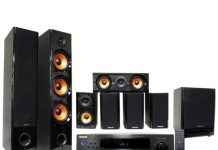 The benefits of HDTV will be noticeable in the coming years as more homes acquire the technology and it becomes more recognizable.
The benefits of HDTV will be noticeable in the coming years as more homes acquire the technology and it becomes more recognizable.
Television entertainment has not changed a lot in the last 30 years in regards to video and audio capabilities.
Some advancement has been made, with the introduction of large screen televisions and the eventual disappearance of VHS recorders and players.
This has been due, in part, to the inadequacy that the analogue system of the television broadcasting signals. There were limitations to the information that could be sent across the airwaves by the analogue system so advances were not necessary.
Now that satellite and cable television have been introduced, changes are starting to take place.
DVDs and Blu-Ray have taken over as the method of choice for consumers to watch their home entertainment, which has brought on the change of analogue to digital entertainment with HDTV being the recognition of this change in entertainment technology.
Many people actually see Blu-Ray as necessary to experience HDTV the way it is meant as Blu-Ray used at its highest potential creates a HD 1080i screen which is the equivalent of sitting in a movie theater.
Blu-ray is a very effective way of storing images and sound that are at a suitable level so that they can reproduce a high definition moving image suited especially to larger screens that are becoming increasingly popular and are now commonplace.
The big advantage of Blu-ray is that the standard of the image it can hold is so much higher, the playback of a Hollywood movie is intensified with much sharper, better defined, images and far more intense colors that give a far more movie-theatre-like experience to the average home.
In fact, the difference can be best acknowledged when you look at the layering on the disk, as a DVD typically contains only .1m of layered substrate to be displayed versus Blu-ray which has a 1.1 layer of substrate.
DVD players will now need to be upgraded to be able to display the high definition format so that viewers will get the levels of viewing pleasure that they require.
DVD players will need to undergo and upgrade as accepted standards for home entertainment are going to rise or people may simply move to Blu-ray.
Part of the reason that Blu-ray presents such a difference is because a blue (hence the name) laser is used to read wavelengths much closer making it possible to store more information.
The short wavelength of Blu-ray measures only 405nm while DVDs need a wavelength of 650nm hence some quality has to be sacrificed due to less data storage space.
The area that tends to get comprised in the case of DVDs is image and pixel detail. Additionally the minimum spot size in which data can be stored and a laser can be focused is 580nm which is much smaller than on a DVD.
At the moment it seems like the only viable option, although people do seem resistant to making the change from DVD to Blu-ray, perhaps the experience of other new technologies that failed to catch on such as Betamax video is making homeowners more cautious.
Yet, with the amazing storage capacity of the Blu-Ray disc at 25-50GB on the small 12 cm disc it seems that the new technology will be sticking around. As the world continues to switch to HD, Blu-Ray will continue to grow in demand offering 60 frames per second interlaced together which frankly, equals out to be a pretty impressive image every second.
The Blu-ray system is the only way at the moment to view HD movies, concerts and so forth when stored on a disk. It is expected that all non HDTV will vanish from homes within the next two years.
DVD players and Blu-ray will start to meet these high definition standards also, so if you are planning to upgrade to HDTV it is recommended that you keep in mind that all analogue equipment will be no longer be available.









